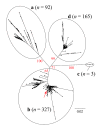A Heterologous Viral Protein Scaffold for Chimeric Antigen Design: An Example PCV2 Virus Vaccine Candidate
- PMID: 32244384
- PMCID: PMC7232224
- DOI: 10.3390/v12040385
A Heterologous Viral Protein Scaffold for Chimeric Antigen Design: An Example PCV2 Virus Vaccine Candidate
Abstract
Recombinant vaccines have low-cost manufacturing, regulatory requirements, and reduced side effects compared to attenuated or inactivated vaccines. In the porcine industry, post-weaning multisystemic disease syndrome generates economic losses, characterized by progressive weight loss and weakness in piglets, and it is caused by porcine circovirus type 2 (PCV2). We designed a chimeric antigen (Qm1) to assemble the main exposed epitopes of the Cap-PCV2 protein on the capsid protein of the tobacco necrosis virus (TNV). This design was based on the Cap-N-terminal of an isolated PCV2 virus obtained in Chile. The virus was characterized, and the sequence was clustered within the PCV2 genotype b clade. This chimeric protein was expressed as inclusion bodies in both monomeric and multimeric forms, suggesting a high-molecular-weight aggregate formation. Pigs immunized with Qm1 elicited a strong and specific antibody response, which reduced the viral loads after the PCV2 challenge. In conclusion, the implemented design allowed for the generation of an effective vaccine candidate. Our proposal could be used to express the domains or fragments of antigenic proteins, whose structural complexity does not allow for low-cost production in Escherichia coli. Hence, other antigen domains could be integrated into the TNV backbone for suitable antigenicity and immunogenicity. This work represents new biotechnological strategies, with a reduction in the costs associated with vaccine development.
Keywords: PCV2 virus; biotechnology strategies; recombinant antigens production; vaccines.
Conflict of interest statement
The authors declare no conflicts of interest.
Figures









Similar articles
-
Reduction of Postweaning Multisystemic Wasting Syndrome-Associated Clinical Symptoms by Virus-Like Particle Vaccine Against Porcine Parvovirus and Porcine Circovirus Type 2.Viral Immunol. 2020 Jul/Aug;33(6):444-456. doi: 10.1089/vim.2019.0201. Epub 2020 Apr 7. Viral Immunol. 2020. PMID: 32255758
-
A novel subunit vaccine co-expressing GM-CSF and PCV2b Cap protein enhances protective immunity against porcine circovirus type 2 in piglets.Vaccine. 2015 May 15;33(21):2449-56. doi: 10.1016/j.vaccine.2015.03.090. Epub 2015 Apr 8. Vaccine. 2015. PMID: 25863115
-
A chimeric porcine circovirus (PCV) with the immunogenic capsid gene of the pathogenic PCV type 2 (PCV2) cloned into the genomic backbone of the nonpathogenic PCV1 induces protective immunity against PCV2 infection in pigs.J Virol. 2004 Jun;78(12):6297-303. doi: 10.1128/JVI.78.12.6297-6303.2004. J Virol. 2004. PMID: 15163723 Free PMC article.
-
Commercial porcine circovirus type 2 vaccines: efficacy and clinical application.Vet J. 2012 Nov;194(2):151-7. doi: 10.1016/j.tvjl.2012.06.031. Epub 2012 Jul 28. Vet J. 2012. PMID: 22841450 Review.
-
Porcine Circovirus Type 2 (PCV2) Vaccines in the Context of Current Molecular Epidemiology.Viruses. 2017 May 6;9(5):99. doi: 10.3390/v9050099. Viruses. 2017. PMID: 28481275 Free PMC article. Review.
Cited by
-
Engineering a bivalent nanoparticle vaccine with PCV2 capsid protein and PRRSV epitopes.J Nanobiotechnology. 2025 Jun 12;23(1):438. doi: 10.1186/s12951-025-03514-8. J Nanobiotechnology. 2025. PMID: 40506710 Free PMC article.
References
-
- Jozala A.F., Geraldes D.C., Tundisi L.L., Feitosa V.A., Breyer C.A., Cardoso S.L., Mazzola P.G., Oliveira-Nascimento L., Rangel-Yagui C.O., Magalhaes P.O., et al. Biopharmaceuticals from microorganisms: From production to purification. Braz. J. Microbiol. 2016;47(Suppl. 1):51–63. doi: 10.1016/j.bjm.2016.10.007. - DOI - PMC - PubMed
Publication types
MeSH terms
Substances
LinkOut - more resources
Full Text Sources
Miscellaneous

